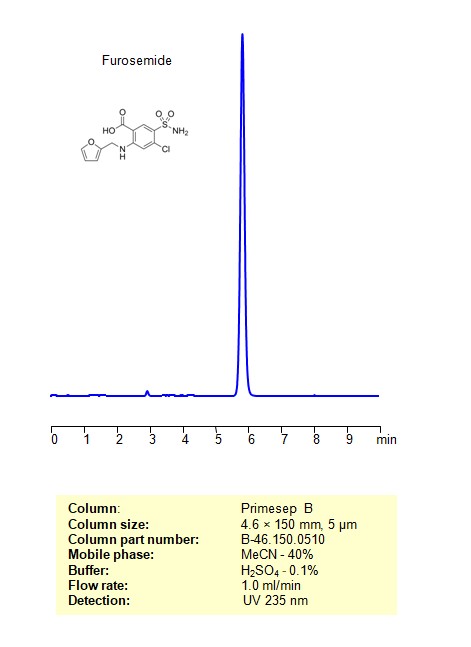HPLC Method for Analysis of Furosemide on Primesep B by SIELC Technologies

High Performance Liquid Chromatography (HPLC) Method for Analysis of Furosemide
Furosemide is a medication commonly used to treat conditions such as edema (fluid retention) and hypertension (high blood pressure). It belongs to a class of drugs known as loop diuretics. Furosemide works by increasing the excretion of water and salts (sodium and chloride) from the kidneys.
Mechanism of Action: Furosemide inhibits the reabsorption of sodium and chloride ions in the ascending loop of Henle in the kidneys. This leads to increased urine production and helps reduce fluid retention.
Uses: Furosemide is commonly prescribed for conditions such as edema associated with congestive heart failure, liver cirrhosis, and renal disease. It is also used to treat hypertension.
Furosemide can be retained, and analyzed using a Primesep B mixed-mode stationary phase column. The analysis utilizes an isocratic method with a simple mobile phase consisting of water, acetonitrile (MeCN), and sulfuric acid as a buffer. Detection is achieved using UV 235 nm
| Column | Primesep B, 4.6 x 150 mm, 5 µm, 100 A, dual ended |
| Mobile Phase | MeCN/H2O – 40% |
| Buffer | H2SO4 – 0.1% |
| Flow Rate | 1.0 ml/min |
| Detection | UV 235 nm |
| Class of Compounds | Sulfonamides, sulphonamides, loop diuretics |
| Analyzing Compounds | Furosemide |
Application Column
Primesep B
Column Diameter: 4.6 mm
Column Length: 150 mm
Particle Size: 5 µm
Pore Size: 100 A
Column options: dual ended





